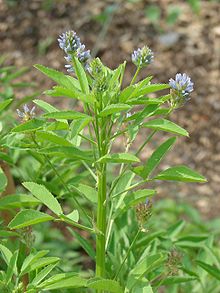| Blue fenugreek | |
|---|---|

| |
| Scientific classification | |
| Kingdom: | Plantae |
| Clade: | Tracheophytes |
| Clade: | Angiosperms |
| Clade: | Eudicots |
| Clade: | Rosids |
| Order: | Fabales |
| Family: | Fabaceae |
| Subfamily: | Faboideae |
| Genus: | Trigonella |
| Species: | T. caerulea
|
| Binomial name | |
| Trigonella caerulea | |

Trigonella caerulea (blue fenugreek,[2][3] blue melilot, Georgian: ულუმბო, უცხო სუნელი - ulumbo, utskho suneli)[4] is an annual herb in the family Fabaceae. It is 30–60 cm tall. Its leaves are obovate or lance-shaped, 2–5 cm long, 1–2 cm wide and saw-toothed in upper part. Its flower stalks are compact, globular racemes, longer than the leaves. The sepals are twice as short as the corolla, its teeth are equal to the tube. The corolla is 5.5-6.5 mm long and blue. The pods are erect or slightly curved, compressed, 4–5 mm long with beak 2 mm. The seeds are small and elongated. It blossoms in April–May, the seeds ripen in May–June. It is self-pollinated.[5]
- ^ "Trigonella caerulea". Germplasm Resources Information Network. Agricultural Research Service, United States Department of Agriculture. Retrieved 2013-07-29.
- ^ USDA, NRCS (n.d.). "Trigonella caerulea". The PLANTS Database (plants.usda.gov). Greensboro, North Carolina: National Plant Data Team. Retrieved 15 December 2015.
- ^ "Trigonella caerulea (L.) Ser. "Blue Fenugreek"". Botanical Society of Britain and Ireland. Retrieved 2019-12-15.
- ^ Rodov V.; Vinokur Y.; Gogia N.; Chkhikvishvili I.D. (2010). "Hydrophilic and lipophilic antioxidant capacities of Georgian spices for meat and their possible health implication" (PDF). Georgian Medical News. 179 (2): 61–66.)
- ^ AgroAtlas, accessed 29 July 2013.